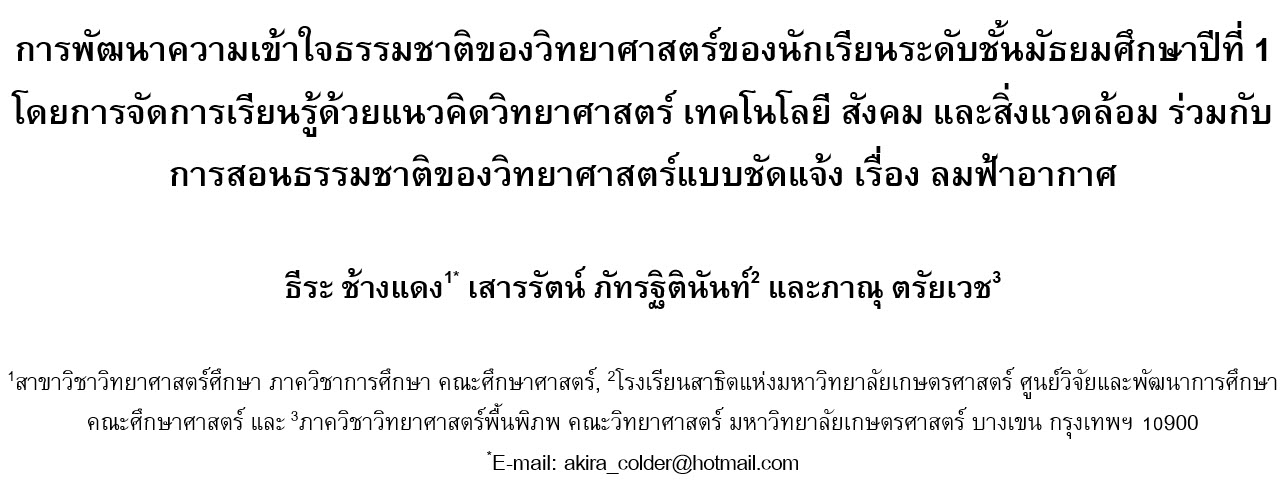การพัฒนาความเข้าใจธรรมชาติของวิทยาศาสตร์ของนักเรียนระดับชั้นมัธยมศึกษาปีที่ 1 โดยการจัดการเรียนรู้ด้วยแนวคิดวิทยาศาสตร์ เทคโนโลยี สังคม และสิ่งแวดล้อม ร่วมกับการสอนธรรมชาติของวิทยาศาสตร์แบบชัดแจ้ง เรื่อง ลมฟ้าอากาศ
Main Article Content
Abstract
Teera Changdang, Sawrarat Patarathitinant and Panu Trivej
รับบทความ: 15 พฤษภาคม 2557; ยอมรับตีพิมพ์: 8 พฤศจิกายน 2557
บทคัดย่อ
การวิจัยนี้มีวัตถุประสงค์เพื่อพัฒนาความเข้าใจธรรมชาติของวิทยาศาสตร์ของนักเรียนชั้นมัธยมศึกษาปีที่ 1 โดยการจัดการเรียนรู้เรื่อง “ลมฟ้าอากาศ” ด้วยแนวคิดวิทยาศาสตร์ เทคโนโลยี สังคม และสิ่งแวดล้อม ร่วมกับการสอนธรรมชาติของวิทยาศาสตร์แบบชัดแจ้ง กลุ่มที่ศึกษาคือ นักเรียนชั้นมัธยมศึกษาปีที่ 1 ปีการศึกษา 2556 ของโรงเรียนขยายโอกาสทางการ ศึกษาแห่งหนึ่งในจังหวัดนนทบุรี จำนวน 47 คน เครื่องมือที่ใช้คือ 1) แบบวัดความเข้าใจธรรมชาติของวิทยาศาสตร์ 2) แบบบันทึกการจัดการเรียนรู้ของครู 3) แบบบันทึกการเรียนรู้ของนักเรียน และ 4) ใบงานจากการทำกิจกรรมของนักเรียน วิเคราะห์ข้อมูลโดยการหาค่าเฉลี่ย ส่วนเบี่ยงเบนมาตรฐาน การทดสอบค่า t และการวิเคราะห์เชิงเนื้อหา ผลการวิจัยพบว่า นักเรียนมีความเข้าใจธรรมชาติของวิทยาศาสตร์หลังเรียนมากกว่าก่อนเรียน (p < .05) แนวทางการจัดการเรียนรู้ที่ทำให้นักเรียนสนใจและเข้าใจธรรมชาติวิทยาศาสตร์นั้นต้องมีการจัดกิจกรรมที่มีการใช้สื่ออย่างหลากหลาย เชื่อมโยงกับชีวิตประจำวัน และนักเรียนมีส่วนร่วมในการทำกิจกรรมโดยมีครูเป็นผู้ให้คำแนะนำอย่างใกล้ชิด
คำสำคัญ: ความเข้าใจธรรมชาติของวิทยาศาสตร์ แนวคิดวิทยาศาสตร์ เทคโนโลยี สังคม และสิ่งแวดล้อม การสอนธรรมชาติของวิทยาศาสตร์แบบชัดแจ้ง
Abstract
This research aimed to study the development of understanding the nature of science using science, technology, society and environment approach in combination with the explicit approach for nature of science in weather learning unit. The subjects were 47 seventh grade students in an extended high school of Nonthaburi province on academic year 2013. The instruments used were as follows: 1) a questionnaire to measure the understanding of the nature of science; 2) field notes – the teacher’s observation about the sample; 3) journal – the student’s record about the lesson; and 4) students’ worksheets. The data were analyzed by calculating average, standard deviation, t-test and content analysis. The results indicated that students’ understandings of the nature of science were higher in posttest than those in pretest (p < .05). The learning management approach according to the science, technology, society an environment along with the explicit nature of science instruction needs to be organized with the various activities of rich media, the application in students’ everyday life, and the participation of activities with closed guidance.
Keywords: Understanding of the nature of science, Science, technology, society and environment, Teaching the nature of science explicit
Downloads
Article Details

This work is licensed under a Creative Commons Attribution-NonCommercial 4.0 International License.
References
กาญจนา มหาลี และชาตรี ฝ่ายคำตา. (2553). ความเข้าใจธรรมชาติของวิทยาศาสตร์ของนักเรียน. วารสารสงขลานครินทร์ ฉบับสังคมศาสตร์และมนุษยศาสตร์ 16 (5): 796-809.
ทัศนี พุฒนอก. (2555). ความเข้าใจธรรมชาติของวิทยาศาสตร์ของนักเรียนชั้นประถมศึกษาปีที่ 5. การประชุมวิชาการ GRC 2012. ขอนแก่น: มหาวิทยาลัยขอนแก่น.
นงลักษณ์ อัฐปัน. (2555). การศึกษาความเข้าใจธรรมชาติของวิทยาศาสตร์ของนักเรียนชั้นมัธยมศึกษาปีที่ 5 ในการเรียนรู้ เรื่อง แสง โดยใช้แนวคิดวิทยาศาสตร์ เทคโนโลยี และสังคม (STS) และบ่งชี้ธรรมชาติของวิทยาศาสตร์. การประชุมวิชาการ International Science Education Symposium (ISES) 2012. ขอนแก่น: มหาวิทยาลัยขอนแก่น.
เบญจพร สาภักดี. (2555). การพัฒนาความเข้าใจธรรม-ชาติของวิทยาศาสตร์ของนักเรียนระดับชั้นประถมศึกษาตอนต้น โดยการจัดการเรียนรู้แบบสืบเสาะหาความรู้ร่วมกับการสอนธรรมชาติของวิทยาศาสตร์แบบชัดแจ้งในหน่วยการเรียนรู้สภาพอากาศ. วิทยานิพนธ์ศึกษาศาสตรมหาบัณทิต สาขาวิทยาศาสตร์ศึกษา. กรุงเทพฯ: คณะศึกษาศาสตร์ มหาวิทยาลัยเกษตรศาสตร์.
พงศ์ประพันธ์ พงษ์โสภณ. (2552). สอนวิทยาศาสตร์อย่างที่วิทยาศาสตร์เป็น. วิทยาศาสตร์ 63 (1): 84-89.
ภัทรวรรณ ไวสาหลง. (2555). ความเข้าใจธรรมชาติของวิทยาศาสตร์ของนักเรียนชั้นมัธยมศึกษาปีที่ 4 โดยใช้การจัดการเรียนรู้ตามแนวคิดวิทยาศาสตร์ เทคโนโลยีและสังคม เรื่อง ความหลากหลายทางชีวภาพ. การประชุมวิชาการ International Science Education Symposium (ISES) 2012. ขอนแก่น: มหาวิทยาลัยขอนแก่น.
สถาบันส่งเสริมการสอนวิทยาศาสตร์และเทคโนโลยี. (2552). หลักสูตรแกนกลางการศึกษาขั้นพื้นฐานกลุ่มสาระการเรียนรู้วิทยาศาสตร์.กรุงเทพฯ: โรงพิมพ์ชุมนุมสหกรณ์การเกษตรแห่งประเทศไทย.
สุทธิดา จำรัส นฤมล ยุตาคม และพรทิพย์ ไชยโส. (2552). ความเข้าใจธรรมชาติของวิทยาศาสตร์ของนักเรียนแผนการเรียนวิทยาศาสตร์ ชั้นมัธยมศึกษาปีที่ 4. วารสารวิจัย มข. 14 (4): 60-374.
สำนักงานคณะกรรมการศึกษาขั้นพื้นฐาน กระทรวงศึกษาธิการ. (2552). ตัวชี้วัดละสาระการเรียนรู้แกน-กลาง กลุ่มสาระการเรียนรู้วิทยาศาสตร์. กรุงเทพฯ. โรงพิมพ์ชุมนุมสหกรณ์การเกษตรแห่งประเทศไทย.
American Association for the Advancement of Science [AAAS]. (1990). The Nature Of Science (online). http://www.project2061.org/publications/sfaa/on line/chap1.htm, March 2, 2013.
Bencze, L. (2012). STSE Education (online). http://www. webspace.oise.utoronto.ca/~benczela/STSEEd.html, March 15, 2013.
Liangkrilas, J. (2009). Development of Level 4 Biology Student’s Understanding of the Nature of Science in the Context of the Unit on Respiration: Explicit and Reflective Inquiry-based Approach. Doctor of Philosophy Thesis in Science Education, Kasetsart University.
National Research Council [NRC ]. (1996). National Science Education Standards. Washington, DC: National Academy Press.
Pedretti, E., and Nazir, J. (2011). Currents in STSE education: Mapping a complex field, 40 Years on. Science and Education 23 (10):601-621.
Yörük, N., Morgil, I, and Seçken, N. (2009). The effects of science, technology, society and environment (STSE) education on students’ career planning US-China Education Review. US-China Education Review 6 (8): 68-74.
